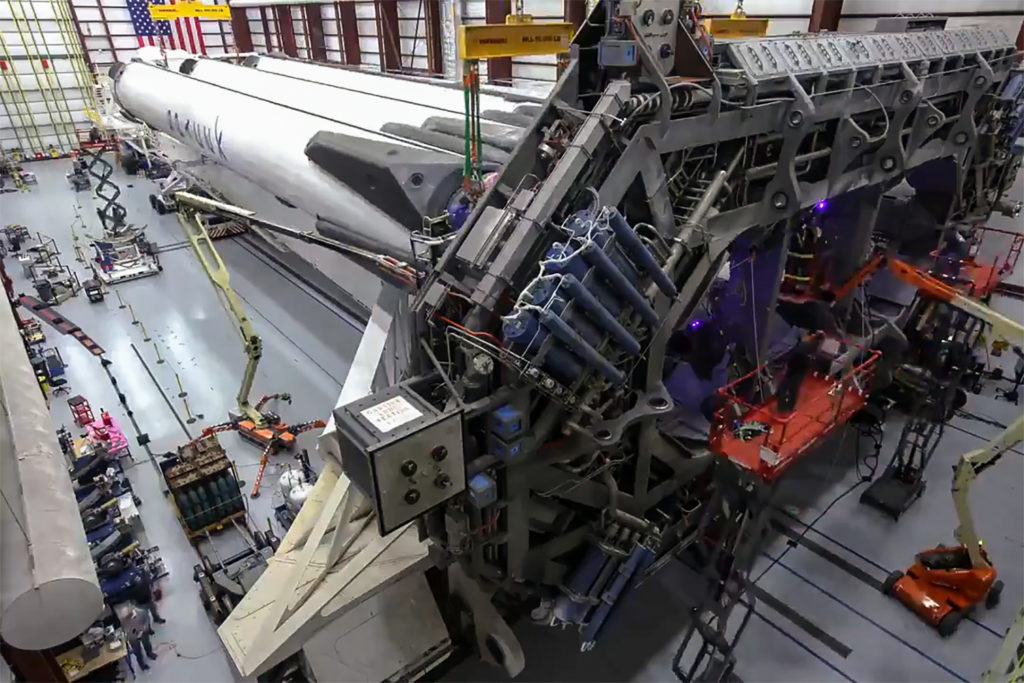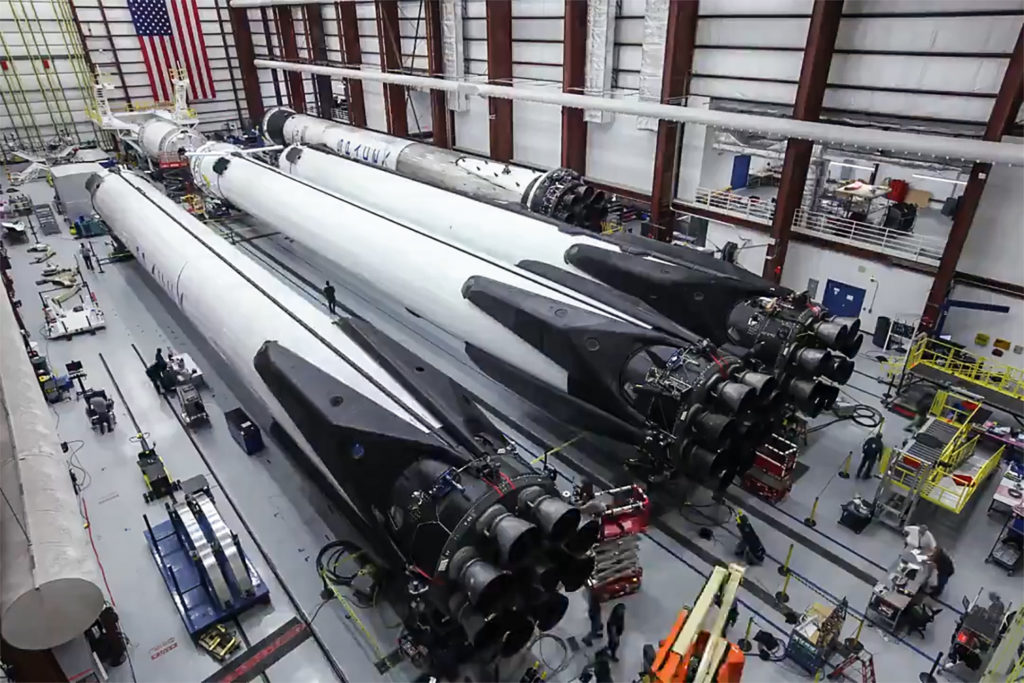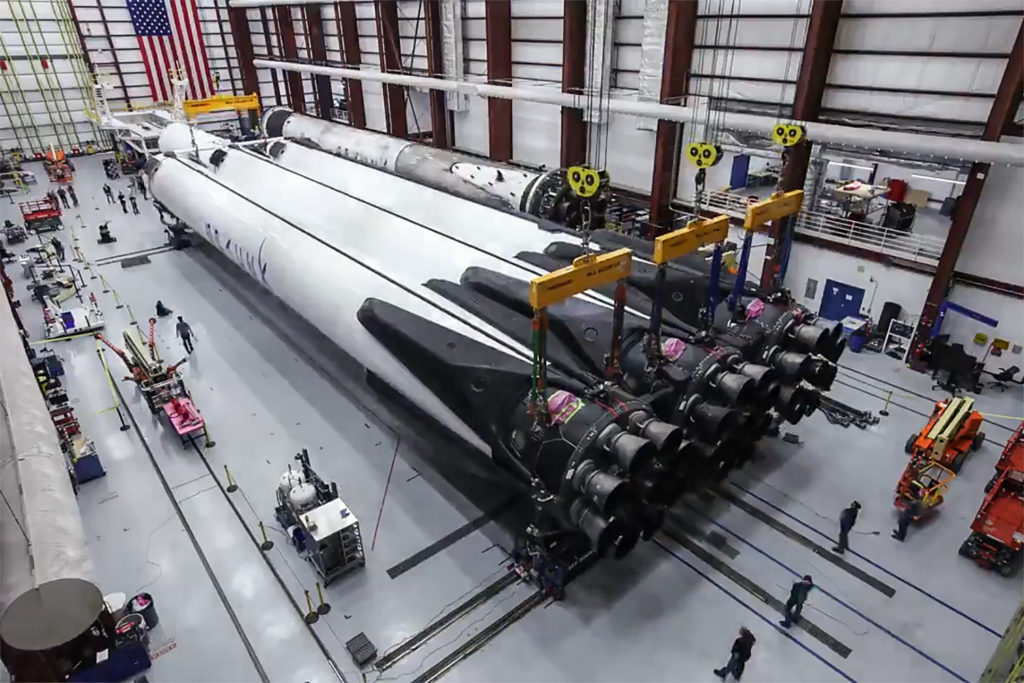News
LaunchPad: Falcon Heavy ready to go for commercial launch debut
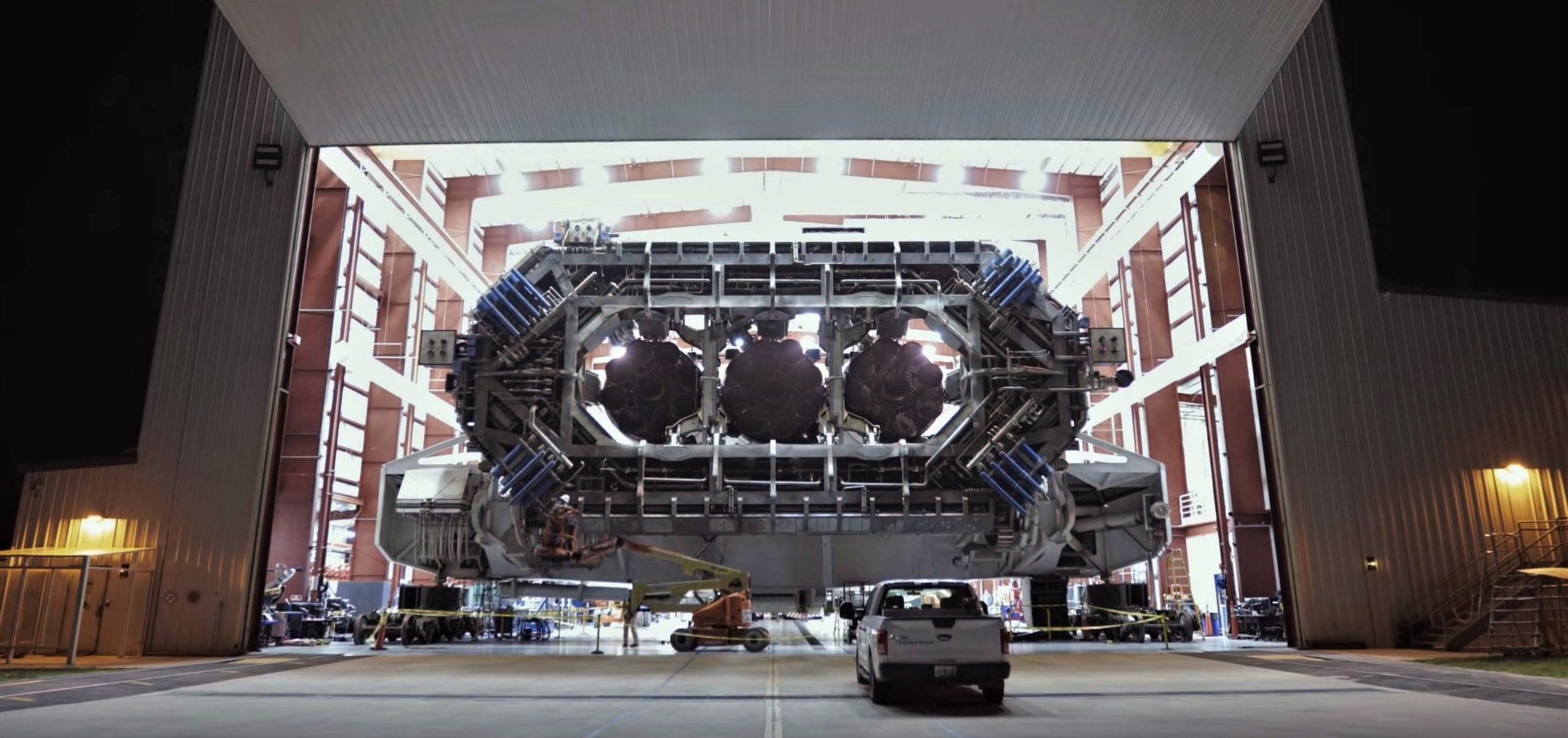
This is a free preview of LaunchPad, one of Teslarati’s member-only launch briefing newsletters. Before each SpaceX launch, I’ll give you an inside look of what to expect and share amazing photos and on-the-ground details after the launch. Become a member today receive all of Teslarati’s newsletters.
SpaceX launch technicians and engineers have officially completed the integration and static fire testing of the second Falcon Heavy rocket ever, nearing the end of preflight preparations for the vehicle’s critical commercial launch debut.
Carrying the commercial communications satellite Arabsat 6A, the rocket will be tasked with placing the massive spacecraft into a high-energy geostationary orbit. After a combination of hurdles and conflicting priorities conspired to delay Arabsat 6A’s launch from mid-2018 to February, March, and eventually, April of 2019, both the spacecraft and rocket are nearly ready to go. If all goes as planned, SpaceX will also complete the first successful launch and near-simultaneous landings of three independent rocket boosters, preparing two of the three boosters for reuse on a launch that could happen as early as June 2019.
When: 6:35 pm EDT, 22:35 UTC (click for your time), April 10th
What: Arabsat 6A, communications satellite, ~6000 kg (13,200 lb)
Where: Pad 39A, Kennedy Space Center, Florida
Boosters: B1052.1, B1053.1, B1055.1
Recovery: Yes; drone ship Of Course I Still Love You (OCISLY) & LZ-1/2
Weather: 80% GO, 4/10

Falcon 9 Block 5, meet Falcon Heavy
- With this Falcon Heavy, SpaceX has effectively built – once again – a center stage that is nearly its own rocket, much like the tortured development of the first vehicle’s center stage can be blamed for a lot of its years of delays.
- Based on Falcon 9 V1.2’s Block 3 iteration, Falcon Heavy Flight 1’s center core was effectively outdated a year before it launched, and Falcon 9 Block 5 debuted just three months after its first and last launch.
- Combined with the center core’s untimely demise when it crashed into the Atlantic after running out of engine starter, the now 14 months separating Flight 1 and Flight 2 of Falcon Heavy can be explained by the rocket’s delayed path to the launch site.
- By the time the first Falcon Heavy’s main components were all present in at the launch site, SpaceX was already building Block 5 rockets and was as few as three months away from completely transitioning its Hawthorne, CA factory to Block 5.
- Due to the extensive changes in production incorporated into Block 5, this was effectively a no-turning-back deal where the cost of transitioning back was simply a non-starter.
- By the time Falcon Heavy had launched, and its center core had smashed itself to pieces on the Atlantic Ocean surface, it was far too late to begin producing a replacement copy. One step further, the process of ramping up Block 5 production had been slowed significantly by the drastic changes made across the board, taking SpaceX to the edge of production-related launch delays over the course of 2018.
- Put simply, building two side boosters and a relatively boutique Falcon Heavy center core – all three of which would be inextricably tied together for the foreseeable future – was not a practical option when three separate Falcon 9 Block 5 boosters could instead support 6-12+ launches over a period of six or so months.
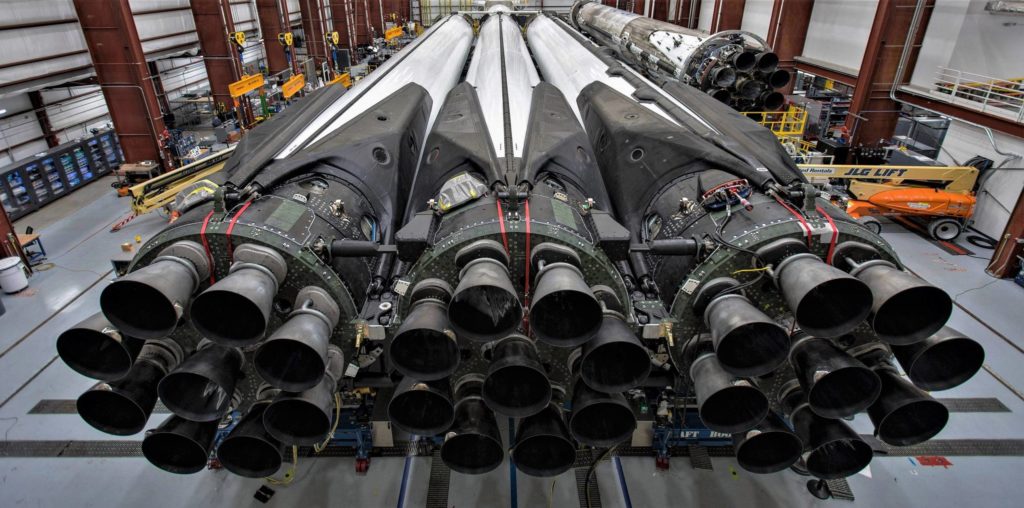
(Hopefully) the first of many
- In the nominal event that SpaceX’s second Falcon Heavy launch is an unqualified success, it’s entirely possible that the doors to new markets could be opened as the world and its many spacefaring customers begin to contemplate the existence of an affordable super-heavy-lift launch vehicle – the first of its kind.
- On the outside, Falcon Heavy can begin to look like a bit of a boondoggle from a business perspective. It will have probably cost no less than $750M-$1B to develop, including the Block 5 modifications needed, and likely brought in less than $100M in gross revenue. It’s a black hole that SpaceX currently dumps huge volumes of cash into, in other words.
- However, this sort of observation is far too pessimistic and gives SpaceX far too little credit after some additional careful analysis. As of today, SpaceX has six public launch contracts for FH, two of which are from the USAF/NRO and likely valued around $130M-$150M.
- Purely commercial contracts for Falcon Heavy will probably be closer to $90M-100M, more than competitive with rockets like Atlas 5, Delta IV Heavy, Ariane 5, and other future vehicles like ULA’s Vulcan.
- Within ~12 months, the USAF will likely have awarded 10-16 additional launch contracts to some combo of Falcon 9 and Falcon Heavy as part of the latest EELV (now NSSL) acquisition phase. Assuming SpaceX is one of the two providers chosen, Falcon Heavy could receive numerous additional contracts for heavy military satellites.
- Additionally, NASA is now seriously considering Falcon Heavy for the launch of flagship missions like Europa Clipper and (maybe, maybe not) even Orion missions to the Moon.
- Falcon Heavy could also be the only vehicle in the world with the performance needed for a number of other missions that could arise from the Lunar Gateway, including launching actual segments of the space station and launching deep space cargo missions resupply said Gateway.
- Only ULA’s Delta IV Heavy can marginally compete with Falcon Heavy’s performance, but it typically costs no less than $300M per launch, a 2-3X surcharge over SpaceX’s offering. Due to the utter and complete lack of competition from both a price and performance perspective, SpaceX could essentially have the heavy life market cornered for something like 48-60+ months.
- Offering a unique product with potentially high demand and no real alternative, SpaceX would not be out of place to raise its profit margins significantly, helping to rapidly pay back the capital investment it put into Falcon Heavy’s extended development.
- Regardless, the future of Falcon Heavy has every right to be even more thrilling and diverse than the already impressive Falcon 9.



You can watch Falcon Heavy’s commercial launch debut live here on April 10th at 6:35 pm EDT (22:35 UTC). We’ll see you after the launch at LandingZone with exclusive photos and on-the-ground details of Falcon Heavy’s center core recovery.

Elon Musk
Elon Musk’s X will start using a Tesla-like software update strategy
The initiative seems designed to accelerate updates to the social media platform, while maintaining maximum transparency.

Elon Musk’s social media platform X will adopt a Tesla-esque approach to software updates for its algorithm.
The initiative seems designed to accelerate updates to the social media platform, while maintaining maximum transparency.
X’s updates to its updates
As per Musk in a post on X, the social media company will be making a new algorithm to determine what organic and advertising posts are recommended to users. These updates would then be repeated every four weeks.
“We will make the new 𝕏 algorithm, including all code used to determine what organic and advertising posts are recommended to users, open source in 7 days. This will be repeated every 4 weeks, with comprehensive developer notes, to help you understand what changed,” Musk wrote in his post.
The initiative somewhat mirrors Tesla’s over-the-air update model, where vehicle software is regularly refined and pushed to users with detailed release notes. This should allow users to better understand the details of X’s every update and foster a healthy feedback loop for the social media platform.
xAI and X
X, formerly Twitter, has been acquired by Elon Musk’s artificial intelligence startup, xAI last year. Since then, xAI has seen a rapid rise in valuation. Following the company’s the company’s upsized $20 billion Series E funding round, estimates now suggest that xAI is worth tens about $230 to $235 billion. That’s several times larger than Tesla when Elon Musk received his controversial 2018 CEO Performance Award.
As per xAI, the Series E funding round attracted a diverse group of investors, including Valor Equity Partners, Stepstone Group, Fidelity Management & Research Company, Qatar Investment Authority, MGX, and Baron Capital Group, among others. Strategic partners NVIDIA and Cisco Investments also continued support for building the world’s largest GPU clusters.
News
Tesla FSD Supervised wins MotorTrend’s Best Driver Assistance Award
The decision marks a notable reversal for the publication from prior years, with judges citing major real-world improvements that pushed Tesla’s latest FSD software ahead of every competing ADAS system.

Tesla’s Full Self-Driving (Supervised) system has been named the best driver-assistance technology on the market, earning top honors at the 2026 MotorTrend Best Tech Awards.
The decision marks a notable reversal for the publication from prior years, with judges citing major real-world improvements that pushed Tesla’s latest FSD software ahead of every competing ADAS system. And it wasn’t even close.
MotorTrend reverses course
MotorTrend awarded Tesla FSD (Supervised) its 2026 Best Tech Driver Assistance title after extensive testing of the latest v14 software. The publication acknowledged that it had previously criticized earlier versions of FSD for erratic behavior and near-miss incidents, ultimately favoring rivals such as GM’s Super Cruise in earlier evaluations.
According to MotorTrend, the newest iteration of FSD resolved many of those shortcomings. Testers said v14 showed far smoother behavior in complex urban scenarios, including unprotected left turns, traffic circles, emergency vehicles, and dense city streets. While the system still requires constant driver supervision, judges concluded that no other advanced driver-assistance system currently matches its breadth of capability.
Unlike rival systems that rely on combinations of cameras, radar, lidar, and mapped highways, Tesla’s FSD operates using a camera-only approach and is capable of driving on city streets, rural roads, and freeways. MotorTrend stated that pure utility, the ability to handle nearly all road types, ultimately separated FSD from competitors like Ford BlueCruise, GM Super Cruise, and BMW’s Highway Assistant.
High cost and high capability
MotorTrend also addressed FSD’s pricing, which remains significantly higher than rival systems. Tesla currently charges $8,000 for a one-time purchase or $99 per month for a subscription, compared with far lower upfront and subscription costs from other automakers. The publication noted that the premium is justified given FSD’s unmatched scope and continuous software evolution.
Safety remained a central focus of the evaluation. While testers reported collision-free operation over thousands of miles, they noted ongoing concerns around FSD’s configurable driving modes, including options that allow aggressive driving and speeds beyond posted limits. MotorTrend emphasized that, like all Level 2 systems, FSD still depends on a fully attentive human driver at all times.
Despite those caveats, the publication concluded that Tesla’s rapid software progress fundamentally reshaped the competitive landscape. For drivers seeking the most capable hands-on driver-assistance system available today, MotorTrend concluded Tesla FSD (Supervised) now stands alone at the top.
News
Elon Musk’s Grokipedia surges to 5.6M articles, almost 79% of English Wikipedia
The explosive growth marks a major milestone for the AI-powered online encyclopedia, which was launched by Elon Musk’s xAI just months ago.

Elon Musk’s Grokipedia has grown to an impressive 5,615,201 articles as of today, closing in on 79% of the English Wikipedia’s current total of 7,119,376 articles.
The explosive growth marks a major milestone for the AI-powered online encyclopedia, which was launched by Elon Musk’s xAI just months ago. Needless to say, it would only be a matter of time before Grokipedia exceeds English Wikipedia in sheer volume.
Grokipedia’s rapid growth
xAI’s vision for Grokipedia emphasizes neutrality, while Grok’s reasoning capabilities allow for fast drafting and fact-checking. When Elon Musk announced the initiative in late September 2025, he noted that Grokipedia would be an improvement to Wikipedia because it would be designed to avoid bias.
At the time, Musk noted that Grokipedia “is a necessary step towards the xAI goal of understanding the Universe.”
Grokipedia was launched in late October, and while xAI was careful to list it only as Version 0.1 at the time, the online encyclopedia immediately earned praise. Wikipedia co-founder Larry Sanger highlighted the project’s innovative approach, noting how it leverages AI to fill knowledge gaps and enable rapid updates. Netizens also observed how Grokipedia tends to present articles in a more objective manner compared to Wikipedia, which is edited by humans.
Elon Musk’s ambitious plans
With 5,615,201 total articles, Grokipedia has now grown to almost 79% of English Wikipedia’s article base. This is incredibly quick, though Grokipedia remains text-only for now. xAI, for its part, has now updated the online encyclopedia’s iteration to v0.2.
Elon Musk has shared bold ideas for Grokipedia, including sending a record of the entire knowledge base to space as part of xAI’s mission to preserve and expand human understanding. At some point, Musk stated that Grokipedia will be renamed to Encyclopedia Galactica, and it will be sent to the cosmos.
“When Grokipedia is good enough (long way to go), we will change the name to Encyclopedia Galactica. It will be an open source distillation of all knowledge, including audio, images and video. Join xAI to help build the sci-fi version of the Library of Alexandria!” Musk wrote, adding in a later post that “Copies will be etched in stone and sent to the Moon, Mars and beyond. This time, it will not be lost.”
